Media | Articles
Your handy 1984–91 Honda CRX buyer’s guide
The third-generation Civic arrived in 1983 as a 1984 model, and it completely changed the game for Honda. This new compact delivered a light, sporty platform that could be folded and pinched into a number of different vehicles. Want a sedan? Got it. Looking for more space? There’s a five-door breadbox wagon or a three-door hatchback that could swallow a good-sized bureau and still get the hatch closed.
But the most notable introduction for 1984 was a certain tiny, Civic-based two-seater hatchback—but what to call it? A hatchback? A GT? A hyper-economy car? Whatever you think it is, Honda named it the CRX. This quirky little thing took center stage on the cover of the 1984 Civic brochure, and it occupied a pretty sizable space inside too.
The Japanese home market used the hyphenated “CR-X” name, while we did away with the punctuation mark in North America. The quarterly Japanese magazine Car Styling ran an incredible preview of the car in 1983, interviewing all of the key staff at Honda responsible for the its design and engineering. “Honda [has] chosen ‘Civic Renaissance’ as the catch phrase symbolizing the concept behind the third-generation model,” the article reads. “The Ballade Sports [as the car was known in Japan] CR-X two-door was launched ahead of the other models on June 23, and is admirably playing its part as image leader in the ‘renaissance’ concept.”
The idea for the CRX was born from something not too far short of desperation at Honda. Car Styling interviewed Honda R&D Director Hidekuni Hagiwara in that 1983 issue, at the dawn of the third-gen Civic’s release. Hagiwara was responsible for smaller-car design and development at Honda R&D, and was concerned about the third generation’s prospects for the future. He “felt an image crisis when the MkII Civic was threatened by newer competitors,” the article notes. “The latest Civic series including the CRX is Honda’s all-out attack on all fronts.”
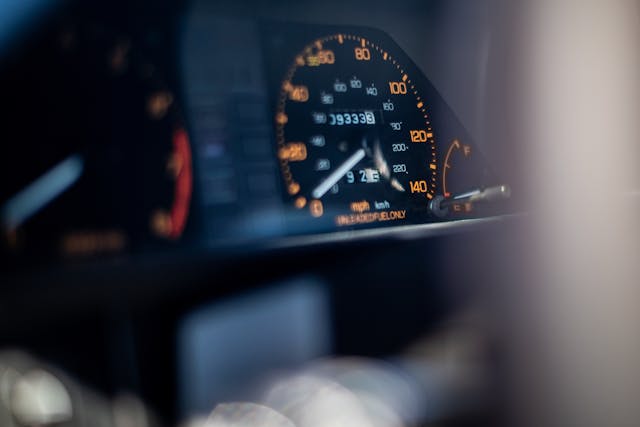
The CRX’s direction came from Honda R&D Managing Director Hiroshi Kizawa who had a staggering track record prior to 1983. He was responsible for the first-generation Accord, and its sporty offshoot, the Prelude. He also worked on the design of the first-generation Civic, a car so important to Honda that he believed “that if the project failed Honda would have to give up its plan of becoming a full-fledged carmaker.” Kizawa was described as “an enthusiast and at the same time a practical engineer.”
Marketplace
Buy and sell classics with confidence
Kizawa’s brief for the CRX distilled those two concepts into two words: “Economy Fast,” a brilliant twist on MG’s “Safety Fast” slogan. It set the tone for the entire project.
1984
The Japanese magazine Car Styling referred to the CRX’s appearance in 1983 as a “dehydrated Camaro look” with “some boy-racer dramatics,” adding, “It may not be a beautiful car, but it certainly is good-looking to most, and at least cute to the indifferent.” Unique to the CRX was the use of HP-Alloy plastics for 40 percent of the exterior panels. These panels were produced in-house at Honda using a high-cycle injection molding process at Honda’s Suzuka Plant. R&D Director Hagiwara’s initial interest in these panels was their potential recyclability. “He saw that if plastic outer panels were to be used extensively and win approval from consumers and the society, he must find ways for their disposal after use.”
Inside, the 1984 CRX and CRX 1.5 had a pyramid-shaped instrument panel, which Car Styling described as being a natural shape that fit between the rim and spokes of the wheel, and essentially mirrored designs from both BMW and Mercedes-Benz. Reclining sport bucket seats were standard on both cars. The only interior advantage of the CRX 1.5 was a tinted strip on the windshield, a standard quartz clock, and dual exterior-mirror remote controls. The three-spoke sport steering wheel was only available on these two cars and the Civic S.
The base CRX was equipped with a 1.3-liter four-cylinder aimed squarely at recent college graduates who wanted a fun, sporty car but didn’t want to spend money on fuel. This engine offered a segment-busting 51 mpg when paired with a five-speed manual transmission, which was the only gearbox available with the base model. (It’s a step up from the four-gear manual standard on the Civic hatch.) To monitor your engine rpm and maximize fuel economy, the CRX was equipped with both a tachometer and a shift light.
The only other rung on the trim ladder was the CRX 1.5, and as the name suggests, you got another 200 cc to play with. The 1.3-liter carbureted four in the base car delivered a sleepy 60 hp and 73 lb-ft of torque. The 1.5-liter provided 76 hp and 84 lb-ft. The 1.5 was also available with a three-speed automatic transmission. Neither car was going to blow your hat off, but at a featherweight 1713 or 1803 pounds, you could drive either car flat-out and have a blast.
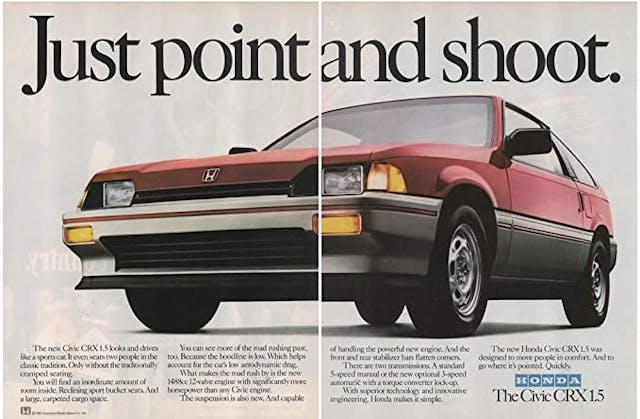
The chassis was Chief Engineer Tateomi Miyoshi’s wheelhouse. He designed the original Accord’s suspension and came up with a simple, effective torsion beam/MacPherson strut design up front, along with a stabilizer bar for the Civic. At the rear, a simple beam axle was supported by trailing links for the CRX, and the CRX 1.5 provided what Christopher Hoffman (a longtime 1987 CRX Si owner and legitimate model expert—more on him later) described as “a clever rear stabilizer bar integrated within the rear beam axle.”
A manual steering rack was standard on both cars, and both featured power-assisted disc/drum brakes, while the CRX 1.5 had ventilated rotors. Both cars sported 13-inch steel wheels, though the CRX 1.5s were slightly wider, with 165/70R13s for the CRX and 175/70SR13 Michelin radials for the CRX 1.5.
Color choices totaled three for 1984 including Victoria Red with Red and Black interior, Greek White with Blue interior, and Baltic Blue with Blue interior. U.S. sales for both 1984 CRX models totaled 48,445 units.
1985
For 1985, Honda renamed the two trim levels. The fuel economy-leading base model was renamed CRX HF, and the performance version was the CRX. Both cars now had a 1.5-liter four in separate states of tune.
Little else changed for this model year until April of 1985, when Honda introduced the CRX Si. The name combined the “S” from the sporty Civic S coupe, and the “i” indicated it was the first CRX with fuel injection. Sequential port fuel injection, to be specific, which increased power significantly to 91 hp and 93 lb-ft of torque at 4500 rpm, turning the CRX Si into what Car and Driver referred to as “even more of a blast on winding roads than it was before.”
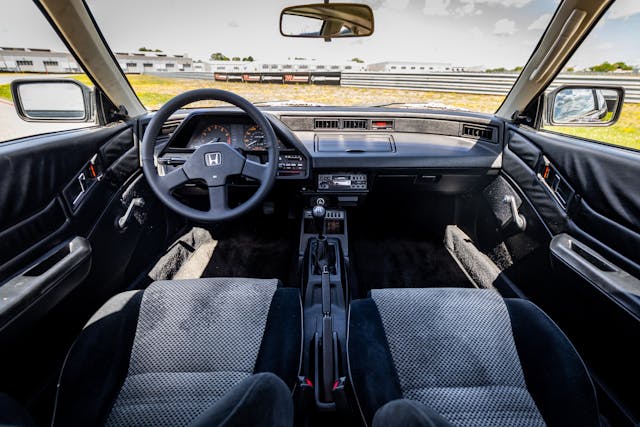
The Si’s engine internals differed from the 1.5 in the CRX. The famous Honda CVCC pre-combustion chambers were deleted in favor of larger intake valves. (The Si had modern three-way catalysts with feedback fuel and air controls that made the CVCC design redundant.) The Si’s intake was also different, and the final drive ratio was 4 percent shorter for a healthier bite on takeoff. The Si received some significant kit inside, too. The inventive sunroof lifted up and over the cabin, and provided a signature look for the top trim CRX. The Si also sported a standard a rear window wiper and washer.
Outside, the wheels went from steel to aluminum alloy with four rectangular holes as a standard feature. Colors for 1985 were unchanged, and in 1985, Honda sold 57,486 CRXs in all trims but it was the Si that made Americans sit up and take notice of how fun a pint-sized Honda could be.
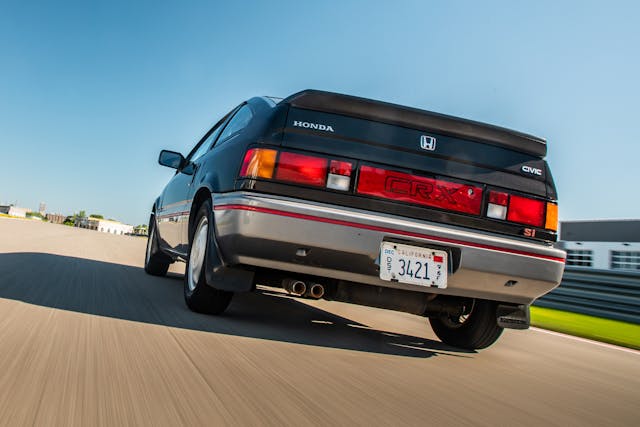
The Si stickered for $7999, more than a thousand bucks above a CRX with the standard 1.5, but there were very few competitive cars available elsewhere in that space. Those that existed were all way more expensive, offered a less enjoyable driving experience with no room for a young person’s normal commuter life. The Toyota MR2 was $11,194. The base Fiero was the same price, but it had General Motor’s low-tech, “Tech IV” Iron Duke four-cylinder with throttle-body injection. There simply was no peer for the CRX Si.
1986
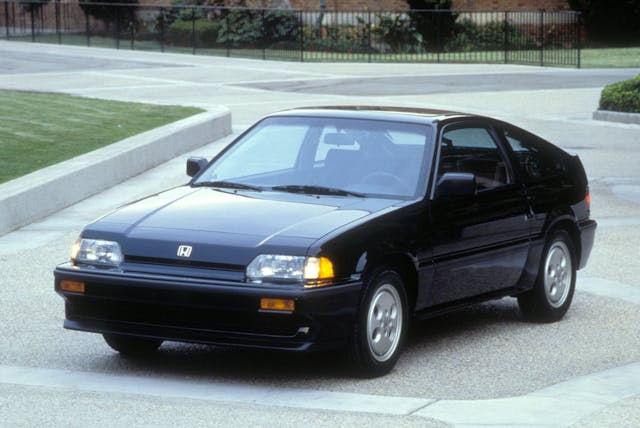
After the Si’s big debut in 1985, the changes for the 1986 model year were more cosmetic. The recessed sealed-beam headlamps made way for a flush aerodynamic units that helped cheat the wind, and the taillights were now smoked. Lower cladding on the Si was painted body color, and received a new rear spoiler and bumper covers, a set of four-hole, alloy 14-inch wheels with Michelins. Interior upgrades included a new console with storage for seven of your favorite Def Leppard cassette tapes.
Both the heater blower and the optional automatic transmission received fourth gears in 1986. The auto transmission was only available on the DX (base) trim.
Colors were unchanged for the HF and DX trims, but the Si was only offered in Baltic Blue, Victoria Red, and a unique Blackburn Black with a Black interior. For 1986, Honda sold 66,629 CRX models, a high-water mark for the model that the manufacturer would never surpass.
1987
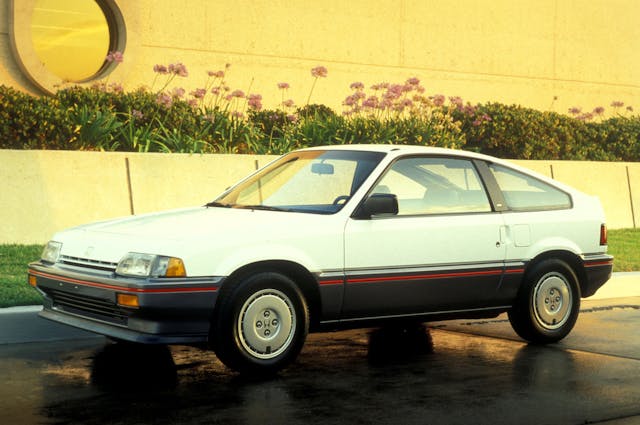
In the final year of first-generation CRX production, Honda held the line with the updates from 1986, essentially carrying over the same car from the prior year. The only significant update was to the color palette. Blackburn Black Metallic would be the only carryover. Honda updated the rest of the colors with Astral Blue Metallic, Sonic Blue Metallic, Rio Red, and Polar White.
For 1987, Honda sold 48,142 CRX models in all trims.
1988
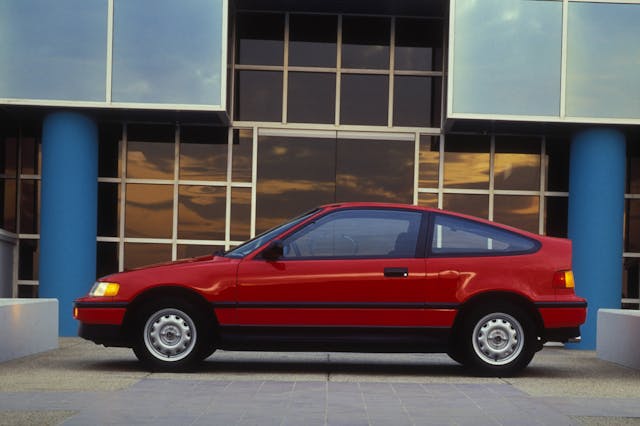
In every conceivable way, the second-generation Honda CRX is a step forward from the first-generation car. Under the skin, numerous improvements further cemented the CRX’s fun-to-drive reputation, scoring it a slot on several publications’ 100 Most Important lists over the last decade.
The suspension was radically new, and gone were the torsion beams up front and beam rear axle. Replacing them was a fully independent double wishbone suspension at all four corners, which not only improved the ride quality but dialed up the handling by a measurable degree. Steering was still a manual rack-and-pinion setup, but the Si got a variable ratio.

All three trim levels (base, HF and Si) had different engines. The base car featured a 16-valve 1493-cc D15B2 engine and dual-point fuel injection (DPFI). Still the fuel-mileage leader, the HF had an eight-valve version of the same 1493-cc D15B6, with multi-point fuel injection (MPFI). The Si received a new 16-valve 1590-cc D16A6 mill and MPFI. The Civic was heavier by a couple hundred pounds, but made up for it with the Si’s 105 hp and 98 lb-ft of torque. Car and Driver loved the 1985 CRX Si’s 9.1-second dash to 60, but in 1988, that time dropped by more than half a second.
At first glance, the body appears to be a fairly simple evolution of the original concept, but the CRX is still among some of the slipperiest designs ever to reach production. The two-seater achieved a 0.29 drag coefficient (Cd), putting it in the same league as cars like the 1966 Lotus Europa, the Lexus CT200h, the Nissan Leaf, and the C6 Corvette.
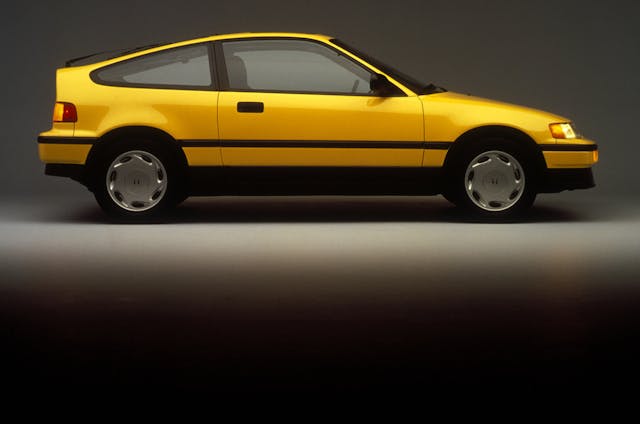
Inside, all CRXs received the same upgrades that the Civic received in its fourth generation. The interior was more refined and less angular, with improved seating. The two lower trims had adjustable headrests, while the Si had high-back bucket seats. Only the HF had a fixed steering column, and both the CRX and the CRX Si received a cargo cover over a 23.2-cu-ft cargo area.
Interestingly, no CRX came from the factory with a radio, speakers, or antenna, but they all came wired for the radio and four speakers. The rear speakers, however, needed an accessory set of interior pieces that capped the rear strut towers with an integrated speaker grille. The Honda catalog offered four different audio head units, along with an equalizer, and they were all dealer-installed.

For 1988, the HF was available in just two colors: Superior Blue Metallic and Polar White. The CRX could be ordered in Superior Blue Metallic, Blade Silver Metallic, Polar White, and Rio Red. The top trim Si had two unique colors: Barbados Yellow and Flint Black Metallic, along with the CRX’s Blade Silver and Rio Red.
All of the revisions added up to a Motor Trend Import Car of the Year award in 1988, while sales climbed with the revision to a full 51,784 units in the USA.
1989
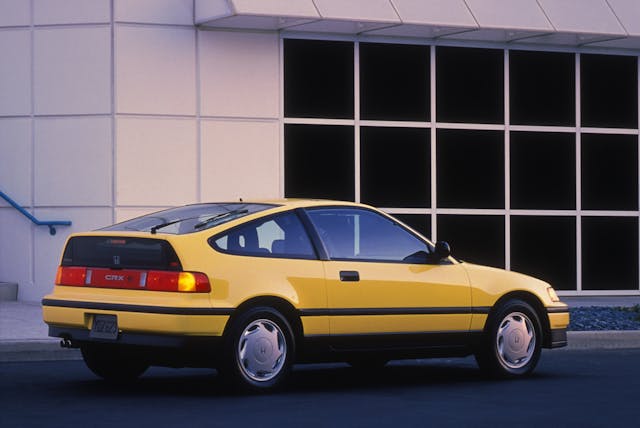
After a major model change in 1988, the revisions for 1989 were fairly limited. Federal mandates for passive safety restraints meant that the top anchor for the shoulder belts were now mounted to the door. For the Si, a new cam profile allowed horsepower to increase marginally from 105 hp to 108 hp.
Colors remained the same this year, and sales dwindled to 39,048 units in the U.S., the worst showing for the CRX at that time.
1990
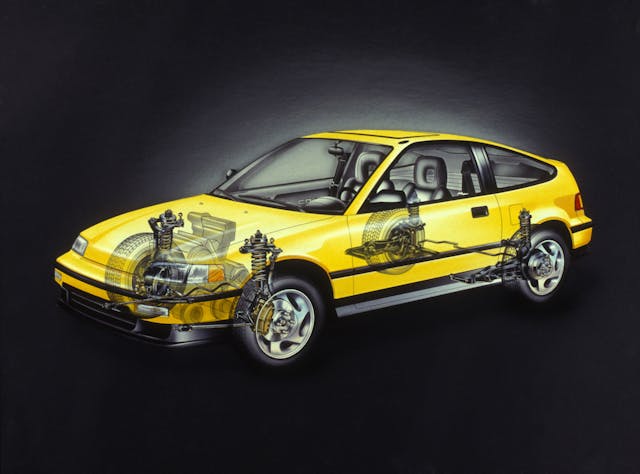
A number of incremental changes occurred in 1990, primarily affecting the interior. Since the beginning, the CRX instrument binnacle was shaped like a frustum, or a flat-topped pyramid. For 1990, all things automotive began a relentless march toward the “melted bean” school of automotive design, and the CRX instrument cluster couldn’t escape that trend. The edges were rounded into a more blob-like shape, and the hazard-light switch moved to the position that was formerly devoted to the rear window defogger.
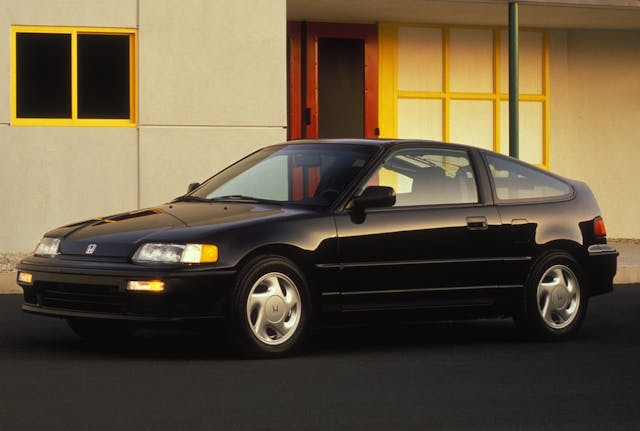
Outside, there were tweaks to the bumper covers, headlamps, and tail lamps. The Si received all-new 14-inch alloy wheels, and behind them sat the only mechanical change: a full set of disc brakes.
In the paint booth, Blade Silver bowed out entirely, with a deeper Torino Red taking its place. Similarly, Superior Blue exited and Celestial Blue arrived, though only available on the base car. All other colors were the same as 1989. Honda sold 40,650 CRX models in the U.S. in 1990.
1991

The final year of availability of the Honda CRX was an essential carryover from 1990, though there were a number of changes to the paint schemes.
If you can tell the difference, Polar White was dropped in 1991 in favor of Frost White. The grin-inducing Barbados Yellow disappeared, and in its place was the similarly tropical Tahitian Green, available only on the Si.
For the final year of sales in the U.S., Honda sold 26,975 CRX models, the lowest number in the car’s history.
Before you buy
For the nitty-gritty of CRX ownership, we reached out to Christopher Hoffman, the aforementioned Si owner and model expert. Petrolicious filmed his CRX Si and gave him the title “Original Fanboy” because of his loyalty to the brand. The ’87 CRX Si that was his first new car (and the first CRX Hagerty ever insured) is now one of four ’80s Hondas in his garage. So when Christopher talks, we listen.
Christopher says all of the CRX’s engines are durable, but suffer a few weak spots. “Timing belt/tensioner/water pump changes are due every 60,000 miles, but if you find a car with no service history, just do this right away as preventive maintenance,” he advises. For most engine parts you’re limited to the aftermarket, since there is scarce parts support from Honda. Hoffman says cylinder-head bolts, which were designed as single-use items, are hard to find.
“The biggest challenge with the carbureted models is the complicated vacuum-line setup and finding a mechanic with the patience and knowledge to deal with it all—but once sorted, drivability is good by period standards,” he says. Lots of these cars had Weber replacement carburetors, and they’re available still, but they should be properly set up with an automatic choke. Many of these cars were “de-vacced” to eliminate lots of unsightly vacuum lines, but Hoffman says that afterwards often leads to complaints about drivability issues, along with the questionable impact on air quality.

The PGM-FI fuel injection is one of few systems on the market with no Bosch elements. Hoffman says it’s fairly reliable, though the injectors are getting harder to find. Cooling fan switches can fail but are easy to diagnose and readily available. If you find a car with the fan switch bypassed to run constantly, Hoffman suggests looking closely at compression and coolant clarity for evidence of a prior overheat, as well as any other shady mechanical work.
“For some reason, people tend to overlook the cheapest and easiest component that can cause a car to run hot: the radiator cap,” he explains. “Instead, they’ll do things to bypass the fan circuit or remove the thermostat.” If originality is a concern, Hoffman explains why good examples are hard to find, because “too many people seem to feel that no ’80s Honda should keep its original engine, and amateur swaps are common.”
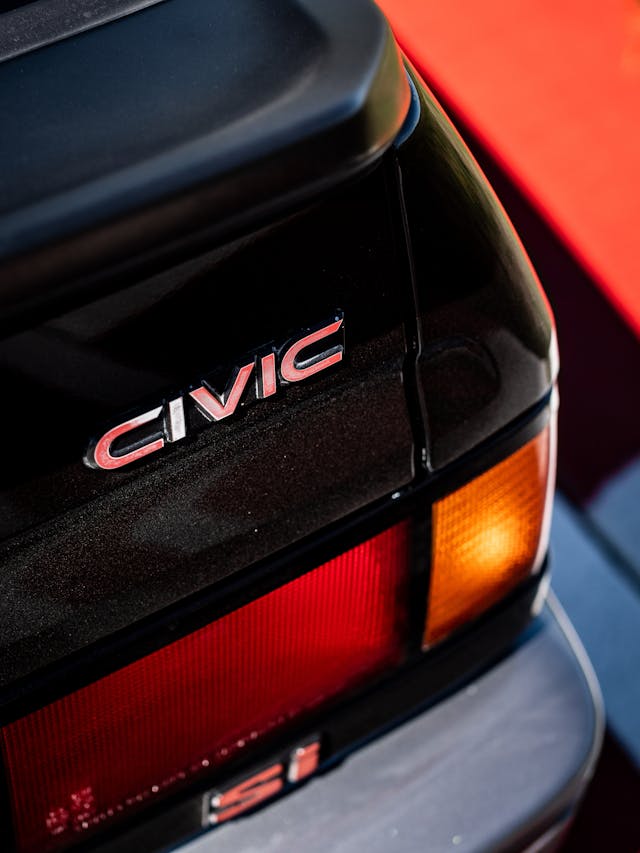
Underneath, replacement struts and shocks are getting harder to find in what Hoffman refers to as the “stock-plus” realm of upgrading. “Many cars have been swapped to coil-overs, and the reversibility of such a mod is questionable,” he says. He adds that upper strut bearings/bushings are very hard to come by, and torsion bars are seemingly not well-understood even though they’re wonderfully simple and easily adjustable.
Brake hardware is mostly available, though the discs are becoming difficult to source. Hoffman indicates that a lot of drum-equipped early CRXs have been converted to Acura Integra rear discs and hubs. The stock setup integrates the hub and rear bearing, and parts can be challenging to locate. Tires are also a challenge—“all the stock tires sizes, even the 185/60R14s of the 1986 and 1987 Si.”
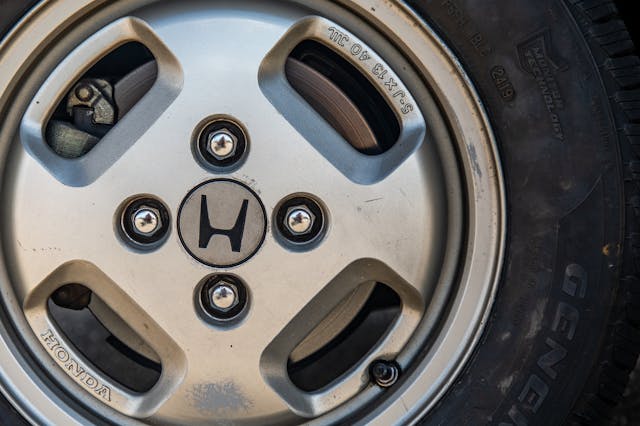
Rust issues are largely dependent on the car’s geographic location and lie in typical areas (wheel arches, sunroof drains) on the car. Issues with those innovative plastic front fenders, mask between the headlights and hood, and side cladding are atypical, though: “I don’t think Honda engineers ever imagined there would be 30-year-old CRXs running around,” says Hoffman. “The panels become brittle and can crack just from the stress of driving or a mechanic leaning on a fender.” He notes that fenders and the header panel are reproduced in carbon fiber by Heeltoe Automotive under the Medieval Pro brand name.
Like all cars with sunroofs, CRXs can leak thanks to a clogged drain tube. The hatchback gaskets also compress, or the hatch can be misaligned causing water entry (and eventual rust). Hoffman says the weakest interior link is probably the 1984 and 1985 door panels, which can wrinkle the way a Mercedes W123 door does. The later models used molded panels that endure quite well. He adds that the dashes tend to hold up quite well.

That said, look for the electrical ravages of poorly installed sound systems over the years. Hoffman says there aren’t really any inherently bad years or models to avoid, but he suggests a 1984 1300 model isn’t going to perform or bring money like an Si, and an automatic DX had better be an ultra-low-mile museum piece. In general, Hoffman suggests finding a car with the fewest mods possible. “Honda engineers probably did know more than you. And they documented it,” he says. He also encourages potential owners to buy a factory service manual. “There’s also an Electrical Troubleshooting manual supplement that’s worth seeking out,” he advises. “Some of the online groups have digitized some of the manuals so they can be downloaded.”
With this in mind, a comprehensive pre-purchase inspection and test drive will ensure you know exactly what the CRX before you shall need, either in the short or long term.
Valuation
CRX values experienced an upward trend over the last few years, but haven’t seen wild spikes, making them a solid value in terms of Japanese collector cars. An apparently clean 1987 Si sold on Bring a Trailer for $22,000 in October of 2021 with just 58,000 miles. In general, a second-generation Si only sells for $2000 more in similar condition, so for the moment, buy the generation you’re most interested in, without much concern for value. In the future, please check here for more timely assessments of Honda CRX values.
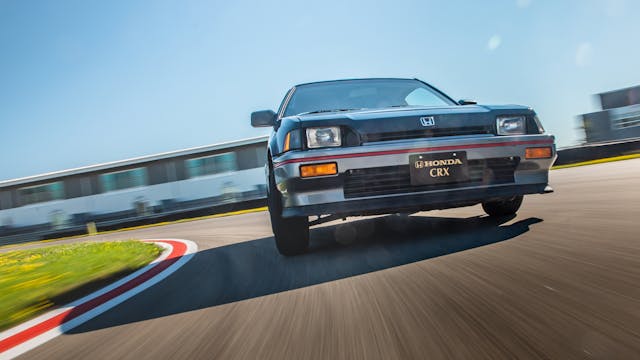
According to the Hagerty Valuation Team, the value of a #2-condition, first-generation CRX is around the $17,000 mark. Second generation cars in the same condition hit $18,000 in the earliest years, and climb up to $19,500 for the final year of production. The Valuation Team notes that the Si was only added to the Hagerty Price Guide in 2019, and the price gap between cars described as #1 or #2 and those described as #3 and #4 is wider than most vehicles. The team notes that the high-water mark for Si prices occurred in 2019, but those two sales haven’t been exceeded since. Median #2 values have increased 43 percent over the past three years.

While the number of Hagerty insurance quotes requested from CRX owners has shot up 196 percent in the past three years, the quoted value overall has dropped by about two percent. Millennials quote 42 percent of CRXs (hardly shocking) while making up 19 percent of the market overall. Right behind them, Gen X quotes 35 percent of CRXs, while making up 32 percent of the market overall. Gen Z, which only makes up six percent of the collector car market, quotes 12 percent of CRXs. Boomers quote 11 percent of the CRXs and dominate with 37 percent of the classic car market. Preboomers? Not sure if they know the CRX exists, since they quote just one percent of CRXs despite comprising six percent of the total market.
Given the relative rarity of clean, unmodified CRX Sis, and their current price level, these cars represent a solid value in 2021 and 2022. Fewer cars exist every year, and more collectors are starting to pay attention to the cleanest examples. We even listed the second-gen Si on our 2020 Bull Market list. If you can get in now, the price of these cars is not going to go down much (if at all!) over the coming years. Get in while you can, and enjoy the ride.
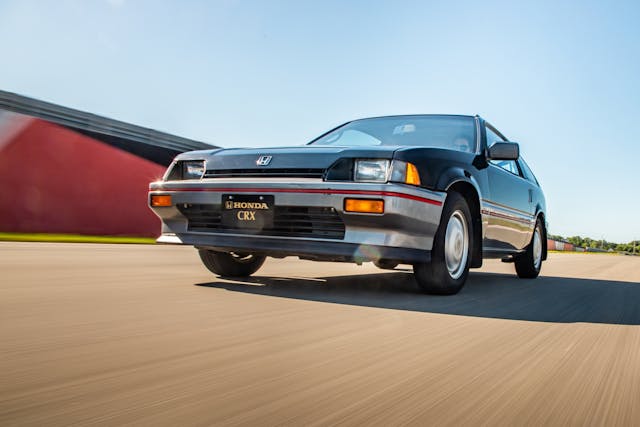









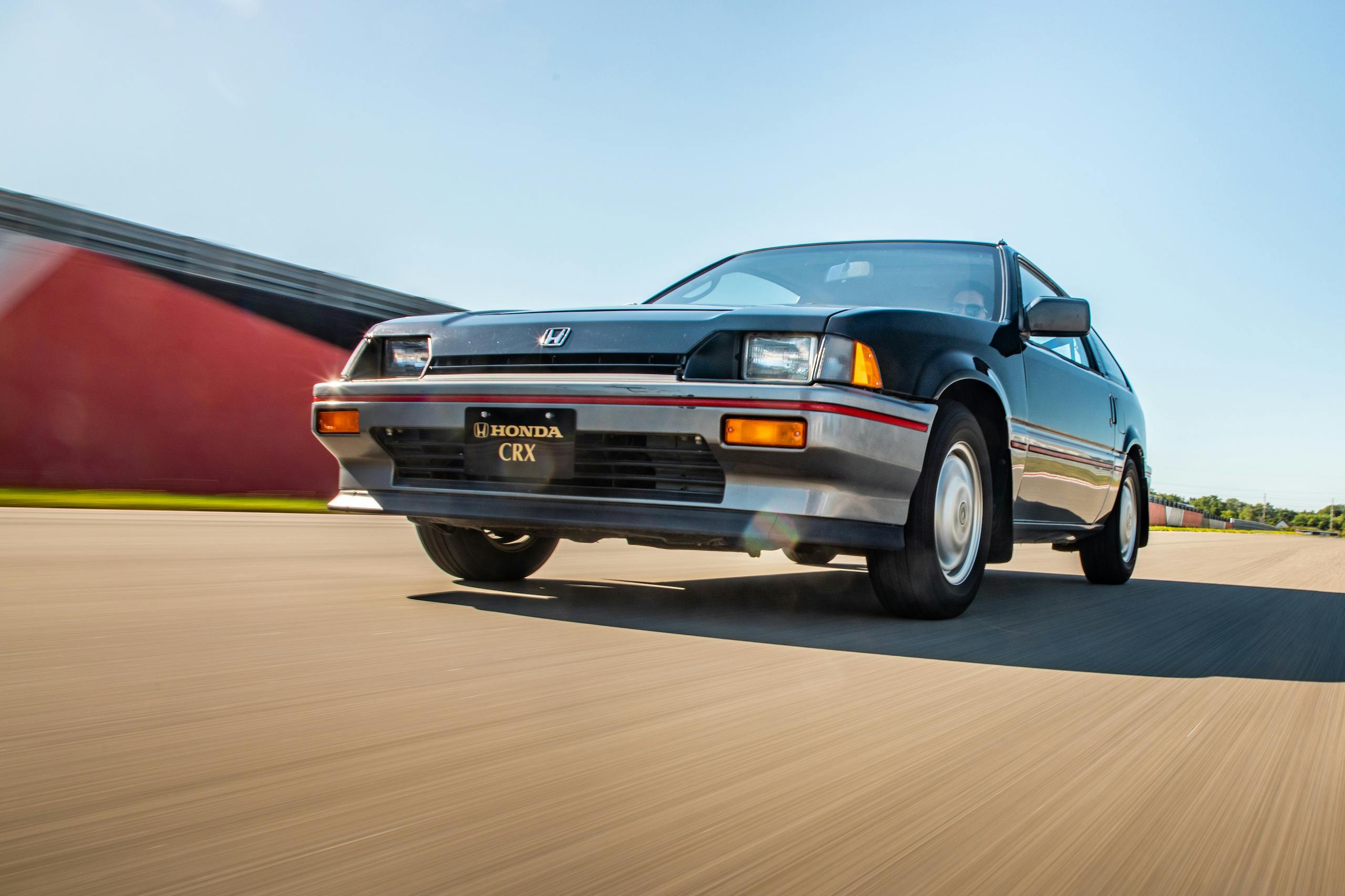
Terrieteague@gmail.com
Thank u for every
I love my 87 crx si, 100% stock and works like a charm. At 125km and being a barn find that needed a lot of work, I can say owning your dream car and being able to take it out and show off is a fun experience, not to mention there might be 5 left around the rust belt in Canada where I live. So you can bet the amount of attention it grabs and it’s a lot.
Keep the Crxs alive!
I know what you mean Devin! I just scored on a 100% bone stock original everything works 86 Hf I found out of state on Craig’s, I immediately caught the next flight out and sealed the deal😊!
As I started my journey back to Tucson from San Diego I stopped at the first Chevron to grab some snacks and top off the tank, while washing the windows a couple car buffs in a lifted 4x pulled in and came over to converse about the rare gem. “Wow that’s awesome you never see those anymore” as they held their cells awaiting photo shots.
The drive back was a blast in my new favorite car, handling great with no shimmy, shakes or vibrations and on one tank of gas!!😁…
More photos to come.